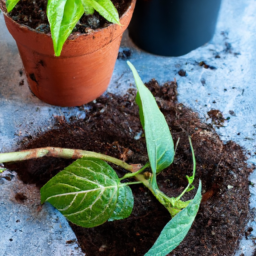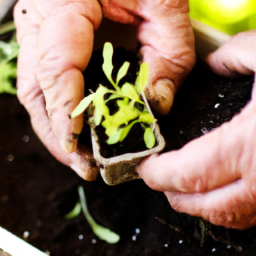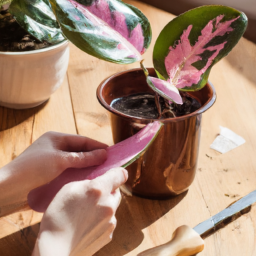
Are you looking to expand your indoor garden without breaking the bank? Look no further than division propagation. Division propagation is a simple and cost-effective method of multiplying your indoor garden by dividing and replanting existing plants. Whether you’re a seasoned green thumb or just starting out, this technique is a fantastic way to increase your plant collection and add variety to your indoor oasis. In this blog post, we’ll explore the ins and outs of division propagation, from selecting the right plants to dividing and caring for them properly. So, grab your gardening gloves and let’s dive into the world of division propagation: multiplying your indoor garden.
The Benefits of Division Propagation in Indoor Gardening
Indoor gardening has gained immense popularity in recent years, allowing plant enthusiasts to bring the beauty of nature into their homes. One technique that has proven to be highly effective in multiplying your indoor garden is division propagation. This method involves separating a mature plant into smaller sections, each capable of growing into a new individual plant. Not only does division propagation allow you to expand your indoor garden, but it also offers several other benefits that make it an excellent choice for plant enthusiasts.
1. Increased Plant Health and Vigor
When a plant is divided, it stimulates new growth and rejuvenation. By separating a mature plant into smaller sections, you are essentially giving each section a fresh start. This process helps to eliminate any overcrowding issues and allows each new plant to have sufficient space, light, and nutrients to thrive. As a result, the divided plants tend to be healthier, stronger, and more vigorous, exhibiting enhanced growth and blooming capabilities.
Furthermore, division propagation can also help in rejuvenating older plants that may have become leggy or less productive over time. By dividing and replanting these older specimens, you can encourage the growth of new, healthier shoots, revitalizing the overall appearance and productivity of the plant.
2. Increased Plant Quantity
One of the primary advantages of division propagation is the ability to multiply your indoor garden without having to purchase new plants. By dividing a mature plant into several smaller sections, you can create multiple individual plants, instantly increasing the number of plants in your collection. This method is especially beneficial if you have a favorite plant that you would like to have more of or if you want to share your plants with friends and family.
3. Cost-Effective Method
Division propagation is a cost-effective way to expand your indoor garden. Instead of buying new plants, you can create more plants from the ones you already have. This method not only saves money but also allows you to experiment with different plant varieties without breaking the bank. Additionally, division propagation can be a sustainable approach to gardening as it reduces the demand for commercially grown plants.
4. Preservation of Plant Genetics
Each plant has its unique genetic makeup, which contributes to its specific characteristics, such as color, size, and growth habit. Through division propagation, you can preserve the genetic traits of the parent plant. This is particularly important if you have a rare or prized plant that you want to maintain in your collection. By dividing the plant and creating new individuals, you ensure that the desirable traits are passed on, allowing you to enjoy the same beauty and qualities in multiple plants.
5. Educational and Rewarding Experience
Division propagation can be an educational and rewarding experience for plant enthusiasts. It allows you to gain a deeper understanding of plant growth and development, as well as the specific requirements of different plant species. By successfully propagating plants through division, you will feel a sense of accomplishment and satisfaction, knowing that you have played a vital role in the growth and multiplication of your indoor garden.
In conclusion, division propagation offers numerous benefits for indoor gardening enthusiasts. From increased plant health and quantity to cost-effectiveness and preservation of plant genetics, this method provides a practical and rewarding way to expand your indoor garden. So, grab your gardening tools, select your favorite plants, and embark on the journey of multiplying your indoor garden through division propagation!

Division Propagation: Multiplying Your Indoor Garden
Step-by-Step Guide to Multiplying Your Indoor Garden through Division Propagation
Are you looking to expand your indoor garden without spending a fortune on new plants? Division propagation is an excellent technique that allows you to multiply your existing plants and create a lush green paradise right in your home. In this step-by-step guide, we will walk you through the process of division propagation, from selecting the right plants to caring for the newly divided ones. Let’s get started!
Selecting the Right Plants for Division Propagation
Not all plants are suitable for division propagation, so it’s important to choose the right ones. Look for plants that have multiple stems or clumps of growth. Some popular choices include snake plants, peace lilies, spider plants, and ferns. These plants tend to naturally form clusters, making them perfect candidates for division propagation.
When selecting plants, ensure that they are healthy and disease-free. Avoid plants that are weak, have yellowing leaves, or show signs of pest infestation. Healthy plants have a better chance of successful division and will thrive once separated.
Once you have chosen the plants you want to propagate, gather the necessary tools. You will need a clean and sharp knife or garden shears, a clean pot or container for each new plant, and a well-draining potting mix.
Preparing the Plants for Division
Before dividing your plants, it’s important to prepare them properly. Start by watering the plants a day or two before you plan to divide them. Moist soil makes it easier to separate the roots without causing damage. However, avoid overwatering as it can make the soil too soggy.
Next, carefully remove the plant from its pot. Gently loosen the soil around the roots and shake off any excess dirt. This will make it easier to see the natural divisions within the plant and determine where to make the cuts.
Inspect the plant for any dead or damaged leaves, stems, or roots. Trim them off using your clean and sharp knife or garden shears. Removing any unhealthy parts will promote the plant’s overall growth and reduce the risk of disease or pest issues.
Dividing the Plants
Now comes the exciting part – dividing the plants! Look for natural divisions or clusters within the plant, such as separate stems or clumps of growth. Carefully separate these divisions using your knife or garden shears. Make clean cuts, ensuring that each division has a good amount of roots and foliage.
Some plants may have stubborn roots that are tightly entwined. In such cases, you can gently tease the roots apart with your fingers or use the knife to carefully separate them. Be patient and avoid pulling or tearing the roots, as this can cause unnecessary damage.
Once you have divided the plant, place each new division into a clean pot or container filled with a well-draining potting mix. Gently press the soil around the roots to secure the plant in place. Water the newly divided plants thoroughly, ensuring that the soil is evenly moist.
Caring for the Newly Divided Plants
After division propagation, it’s crucial to provide the newly divided plants with the care they need to thrive. Place the pots in a location that receives bright, indirect sunlight. Avoid exposing them to direct sunlight, as it can scorch the delicate foliage.
Water the plants regularly, keeping the soil consistently moist but not waterlogged. Monitor the moisture level by inserting your finger into the soil. If it feels dry at a depth of about an inch, it’s time to water. Remember to adjust the watering frequency as needed based on the specific requirements of each plant.
As the plants establish themselves in their new pots, you may notice some wilting or drooping. This is normal and should resolve within a few days as the plants adjust to their new environment. If any stems or leaves appear unhealthy, remove them promptly to prevent the spread of disease.
Finally, be patient and give your newly divided plants time to grow and develop. With proper care and attention, they will soon flourish and contribute to the beauty of your indoor garden.
Division propagation is a rewarding technique that allows you to multiply your indoor garden without breaking the bank. By following this step-by-step guide, you can confidently propagate your plants and enjoy the satisfaction of watching them thrive. So, roll up your sleeves, grab your tools, and get ready to expand your indoor garden through division propagation!

Common Mistakes to Avoid when Propagating Divisions in Your Indoor Garden
Introduction
Welcome to the world of indoor gardening! If you’re looking to expand your collection of plants, division propagation is a fantastic technique to multiply your indoor garden. However, as with any gardening method, there are common mistakes that beginners often make. In this guide, we will walk you through the do’s and don’ts of propagating divisions, ensuring that you have a successful and thriving indoor garden.
Choosing the Right Plants for Division Propagation
When it comes to division propagation, not all plants are created equal. It’s essential to choose the right plants that are suitable for this method. Some plants that are commonly propagated through division include spider plants, peace lilies, snake plants, and various types of ferns.
It’s important to note that not all plants can be divided. Some plants have a single root system that cannot be easily separated, while others may not respond well to division. Before attempting division propagation, research the specific plant species to ensure it is suitable for this technique.
Additionally, choose healthy and mature plants for division. Plants that are weak or diseased may not survive the division process, leading to disappointment and wasted effort. Always select plants that are thriving and have strong root systems.
Preparing the Plants for Division
Once you’ve chosen the right plants for division propagation, it’s time to prepare them for the process. Start by watering the plants thoroughly a day or two before dividing them. This will ensure that the plants are well-hydrated and have a better chance of recovering from the division.
Next, carefully remove the plant from its pot, being gentle to avoid damaging the roots. Gently shake off excess soil, and if necessary, use a clean knife or shears to separate the plant into smaller sections. Ensure that each section has a sufficient number of healthy roots and shoots for successful propagation.
After dividing the plant, it’s crucial to trim any damaged or excessively long roots. This will encourage new root growth and help the plant establish itself in its new container or location. Remember to use clean and sharp tools to minimize the risk of introducing diseases or infections to the plant.
Providing the Right Growing Conditions
Once the divisions are prepared, it’s essential to provide them with the right growing conditions to ensure their successful establishment. Start by selecting appropriate containers or pots for each division. Make sure the containers have drainage holes to prevent waterlogged soil, which can lead to root rot.
Choose a well-draining potting mix that is suitable for the specific plant species. Avoid using heavy garden soil, as it tends to retain too much moisture and can suffocate the roots. Fill the containers with the potting mix, leaving enough space for the divisions to settle comfortably.
Place the divisions in their respective containers, ensuring that the roots are adequately covered with soil. Gently press the soil around the divisions to secure them in place. Water the divisions thoroughly after planting, allowing the excess water to drain away.
Finally, find an appropriate location for your newly divided plants. Consider their light requirements and place them accordingly. Most indoor plants thrive in bright, indirect light, away from drafts or extreme temperature fluctuations. Monitor the moisture levels in the soil and adjust your watering routine accordingly.
Conclusion
Propagation through division is a fantastic way to multiply your indoor garden. By avoiding common mistakes and following the step-by-step guide provided, you can ensure successful propagation and enjoy a thriving indoor garden filled with beautiful and healthy plants. Remember to choose the right plants, prepare them carefully, and provide the optimal growing conditions. Happy propagating!
Essential Points
So you’ve successfully started your indoor garden and it’s flourishing beautifully. But now you’re faced with a new challenge – how to keep expanding it without overcrowding the space? The answer lies in division propagation, a simple and effective technique that allows you to multiply your indoor garden and create even more lush greenery.
Division propagation involves separating and replanting sections of your existing plants to create new ones. It’s a great way to rejuvenate older plants, control their size, and create a more balanced and diverse garden. To get started, carefully remove the plant from its pot and gently divide the root ball into smaller sections. Be sure to keep each division intact, with its own roots and foliage. Then, simply replant each division in its own pot with fresh soil and water thoroughly. With proper care and attention, these divisions will grow into healthy and thriving plants, ready to be added to your indoor garden.
Here are some FAQs you’d be interested in:
Q1: What is division propagation and how does it work?
A1: Division propagation is a method of multiplying your indoor garden by dividing a mature plant into smaller sections, each of which can grow into a new plant. It involves carefully separating the plant’s root system and replanting the divided sections in separate pots or areas. This process allows you to create multiple plants from a single parent plant, helping you expand your indoor garden quickly and easily.
Q2: Which plants are suitable for division propagation?
A2: Many plants can be propagated through division, but some of the most common ones include ferns, succulents, snake plants, peace lilies, and spider plants. These plants typically have clumping or spreading growth habits, making them well-suited for division propagation. However, it’s always a good idea to research specific care instructions for each plant species to ensure successful propagation.
Q3: When is the best time to perform division propagation?
A3: The ideal time to perform division propagation depends on the specific plant species. In general, it’s best to divide plants during their active growth period, which is typically in spring or early summer. This allows the divided sections to establish themselves and develop strong root systems before the dormant winter months. However, some plants may have different optimal propagation times, so it’s important to research and follow specific guidelines for each plant.
Q4: How do I divide a plant for propagation?
A4: To divide a plant for propagation, start by carefully removing it from its pot or the ground. Gently shake or brush off excess soil to expose the root system. Use clean, sharp gardening tools to separate the plant into smaller sections, ensuring that each section has its own set of roots and shoots. Be cautious not to damage the roots or stems during this process. Once divided, replant each section in a suitable pot or area with well-draining soil, and provide proper care and maintenance for optimal growth.
Q5: What care should I provide to divided plants after propagation?
A5: After division propagation, it’s essential to provide proper care to ensure the success of the newly divided plants. Place them in an area with appropriate lighting conditions based on their specific requirements (e.g., bright indirect light for most houseplants). Water the plants thoroughly but avoid overwatering, as excessive moisture can lead to root rot. Monitor the soil moisture levels and adjust watering accordingly. Additionally, follow any specific care instructions for the plant species, such as fertilizing, pruning, or providing humidity if necessary. Regularly check the plants for signs of stress or disease and address any issues promptly to promote healthy growth.
Dr. Olivia Green is a botanist with over two decades of experience in indoor plant cultivation. She holds a Ph.D. in Plant Biology and has dedicated her career to researching plant behavior in controlled environments. Dr. Green is passionate about helping plant enthusiasts master the art of indoor gardening through her extensive knowledge and practical insights.


